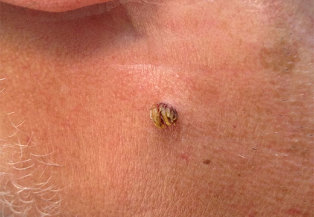
Papillomas on the neck are viral skin growths that are a symptom of the papilloma virus. It is invisibly present in the body of 90% of people on the planet. Carriers include young children, newborns, the elderly, young people and pregnant women. The infection vaguely enters the body and waits for years for the right moment to attack. The growth, the increase in the number of neoplasms, testifies to activity.
Causes and symptoms of papillomatosis on the neck
The impetus for the development of the disease is a decrease in immunity. The following reasons for the appearance of papillomas on the neck may affect the condition:
- bad habits - smoking, alcoholism;
- digestive system diseases;
- serious chronic diseases;
- avitaminosis, anemia;
- long-term drug therapy;
- stress, prolonged depression;
- allergic reactions;
- malnutrition;
- hormonal changes that trigger menopause, puberty, pregnancy.
The proliferation of papillomas on the neck often causes hormonal imbalance and endocrine diseases, leading to diabetes mellitus, followed by hyperthyroidism and obesity.
Papillomas appear on the child's neck as a result of infection from the mother while passing through the birth canal, feeding, or through household contact (through toys, dishes and other items used by the virus carrier).
Initially, individual elements can be created and eventually change their size and color.

How to recognize viral growth:
- growth has a small diameter; The
- structure is soft, loose; The
- shape is flat or oblong, convex, papillae on one leg;
- color - light like the surrounding skin, darkens over time; The
- appearance is accompanied by itching and burning.
The growth consists of a thin epidermis and is easily damaged. If the integrity is violated, acute pain, itching, bleeding appears.
Appearance characteristics of many small papillomas
Papilloma is a viral formation that has the ability to rapidly reproduce by infecting the surrounding healthy tissues. This happens when you touch the infected element with your hands or objects and transfer the particles from the body to the mucous membranes.
The neck is an open area that is regularly exposed to negative factors. Several types of the virus like to live in this part of the body. It spreads due to the person's lack of personal hygiene, rubbing with the collar from dresses, shirts, sweaters, bra straps, scarves. Irritated, rubbed skin with impaired blood microcirculation is a suitable environment for papillomatous infection.
A man is most at risk, less often a woman or a child. Representatives of both sexes and different age categories turn to a doctor for help.
Increases the activity of the virus, increases perspiration, the use of cosmetic creams that do not allow oxygen to pass into the skin. The changed epidermal cells begin to grow rapidly. As a result, a person has many small papillomas on the neck and décolleté.
Diagnosis of Disease
You need to contact a dermatologist to diagnose and prescribe treatment. The doctor will conduct a visual examination, prescribe an examination.
The growth is initially examined under a dermatoscope to examine the structure.
Neoplasms of papillomatous nature are subjected to PCR diagnosis to examine the DNA of the disease. It allows you to determine the strain to give an idea of the quantitative content of viral cells in the body. With diagnosis, you can roughly find the duration of infection and identify the carrier. The doctor can find out what the cause of the activity of the virus - a simultaneous decrease in immunity or exacerbation of a chronic form.
If a decision to removeis made, a biopsy is also requested. The resulting tissue is sent for cytological and histological examination. Cells, giving a reliable response - a dangerous element or not, what is the degree of malignancy, how likely is it to turn into cancer?
Based on the results, the doctor recommends further treatment and excision. It is recommended to undergo periodic examinations of papilloma virus carriers, PCR diagnosis for timely detection of altered elements and prevention of exacerbation of the disease.
Treatment methods
Therapy is developed for each patient individually. If papillomas do not have an oncogenic condition, you can be treated at home with approved medications. For oncogenic growths, removal with subsequent treatment is indicated. The option is chosen by the doctor taking into account a number of factors: the size of the growth, the area of the lesion, the presence of contraindications, the adult or child age of the patient. If rebirth has begun, the stage of development of oncology plays an important role.
Pharmaceutical Medicine
Complex therapy is used to combat papillomas on the neck. It is important to act on the pathogen from outside and inside. Medicines produced in the form of tablets, injections, powders will help increase immunity, body resistance.
Medicines are allowed to be used strictly according to doctor's prescription. Any drug has side effects, contraindications for use. Only a qualified specialist will be able to choose a medicine, taking into account the results of the patient's individual examination.
Ointments are used to target the virus directly. It inhibits activity, prevents proliferation and reduces in size. If the growth is small, it disappears after 1-2 weeks of treatment, for large papillomas it takes up to 8 weeks.
Keratolytic agents will help to correct the defect quickly:
- is a medicine that comes in the form of an oily liquid. A drop of solution is gently applied to the element, preventing it from spreading to the surrounding tissue. Apply the treatment at least 5 times, at minimum intervals for 10-45 minutes. After the procedure, the growth may hurt, darken and eventually disappear;
- solid form drug. Its purpose is to remove warts and papillomas without leaving marks and painlessly. Thanks to the pen, it is possible to prevent re-infection and the emergence of new formations on the skin;
- is a product that comes in the form of a transparent liquid. It is guaranteed to remove papillomas of different sizes. Definitely aggressive preparation is applied to the growth. It starts peeling and drying one week after processing.
When the examination confirms that the neoplasms are of good quality, the home method can be used to remove warts and papillomas.
Lifting in healthcare facilities
In case of regular damage to large papillomas, it is recommended to remove one of the available medical methods. The following safe and effective techniques are available for surgery:
- laser coagulation. It allows you to get rid of cosmetic defects without leaving scars and pain. The doctor burns the growths without affecting healthy skin. The beam does not touch the infected epidermis and the papilloma virus does not spread further, relapses are excluded. It is used in cases where small papillomas are found in large numbers in one area. Preliminary study of oncogenicity is mandatory, after evaporation it is impossible to carry out histology, there is no material;
- electrocoagulation. Common method for removing various skin growths. The high frequency current cuts the affected tissue while simultaneously cauterizing the vessels. This prevents the disease from recurring in the treated area. A scar remains after the procedure. Shown for small items. It is allowed to excise many papillomas per session;
- cryiodestruction. One of the oldest treatments for dermatological problems. Liquid nitrogen acts on the nerve endings of the growth and kills them. Color changes and crust formation are observed after the procedure. Pain and anchor may appear. Complete drying takes place after a few days;
- radio waves. A radio knife is used to remove the warts. It works on the basis of high frequency waves. Due to the absence of skin contact, the risk of recurrence is minimal;
- surgical removal. It is prescribed to the patient if the formation reaches a large size or the cells begin to become cancerous and an emergency surgery is required. The surgeon grabs a small piece of healthy skin and cuts the papillae with a scalpel. This reduces the risk of developing oncology and blocks papillomatosis.
method is chosen by the physician. If necessary, local anesthesia is given to the patient.
Home remedies for papillomas on the neck
You can use the popular experience of HPV treatment if there are contraindications to surgical damage. Before starting use, you should consult your doctor. A specialist will help you choose a recipe and advise you on precautions. If you do not follow the rules of personal hygiene and maintain healthy skin, new papillomas will grow at the treatment site, the removed elements will grow.
№1Soap (household or tar type). Wash the affected area, lather with a thick layer of soap. Apply a polyethylene compress and bandage / adhesive plaster on top. Replace until the formation disappears.
№2Chop the leaves and stems of celandine. Squeeze the juice with cheesecloth. Treat each item with the resulting liquid. Repeat the procedure every 3 hours for the first few days, then every 3 days. This is harmful for pregnant women and young children!
№3Cut or break the aloe leaf and attach it to the sore spot with a cut. Cover the top with a polyethylene bandage. Make a compress before going to bed, clean in the morning. Repeat until the skin is clear.
# 4Lubricate the papillae with apple cider vinegar. Be careful if you have too many papillomas on your neck, don't touch healthy skin. It is recommended to pre-treat the neck with oil cream for protection. Cover the treated growths with adhesive tape.
An important condition for achieving a stable therapeutic effect is the regular use of prescriptions. Be patient. Homeopathy works for a long time, but it is reliable.
Danger and predictions
If not removed, the small papillomatous formation can infect the surrounding healthy skin and cover the neck, face, arms and other parts of the body. Papillomas are fragile, a violation of their integrity can lead to bleeding, the attachment of a secondary infection.
Painful, bleeding, swollen tumors are dangerous. These symptoms indicate the development of carcinomatosis, a malignant transformation of tissues. The virus causes the cells of the epidermis to grow uncontrollably and turn into cancer by damaging the skin. A qualified professional can stop or prevent the process. Regular examination and treatment is a prerequisite for living with the papilloma virus.
Dark brown warts on the body or body rarely attract the attention of the user if they do not spoil the appearance or are painful. In vain such a carelessness towards one's own body and skin can become pitiful. Leg enlargement is the main symptom of papilloma virus. It indicates that the body was infected at the time it was attacked. It is possible to correct the situation and restore health, but only in conditions of complex treatment.















































































